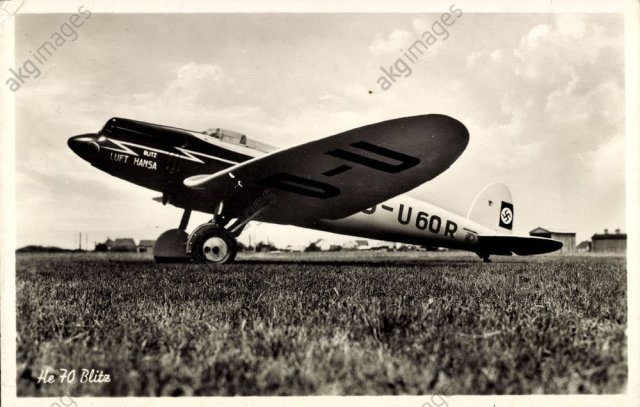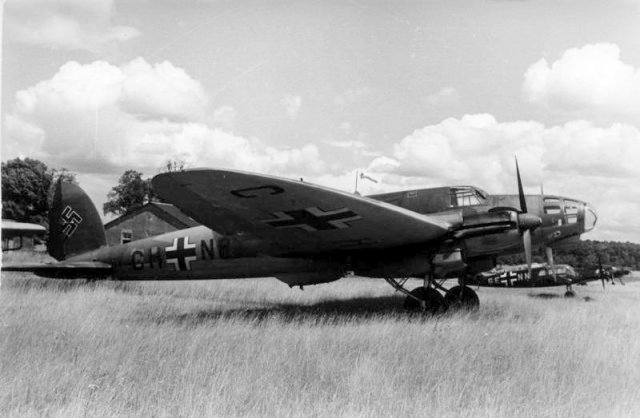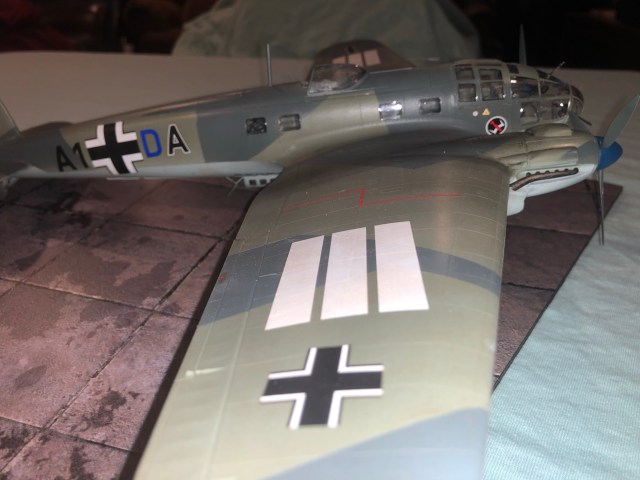Another of World War II’s “iconic” types, the He 111 became a symbol of irresistible Nazi air power in the opening months of the War.

That lasted for about a year, until the invulnerability myth was shattered in the skies of southeast England. Let’s look at a Heinkel from the Battle of Britain.
After World War I Germany was barred from having an air force. Of course we know how well that worked out, in the early 1930s Germany began working on new “civilian” aircraft types that would facilitate rebuilding and training of a military air arm. Ernst Heinkel was among those eager to profit from the forthcoming civilian/military air contracts. Along with chief designers, Siegfried and Walter Gunter he started work on what was to be the “world’s fastest airliner”. The design borrowed the wing platform from the company’s successful He 70 Blitz light airliner.

He 70 Blitz. The wing and tail surfaces were directly copied and enlarged for the bigger He 111.
The new twin engine airliner first flew in 1934 and it was fast with a speed over 250 kts, but it fooled few observers that it was really meant to haul passengers and mail. Indeed, the first militarized version was the He 111A. But the type proved underpowered and the whole production run was sold to China. By the time the He 111B flew in 1936 all pretense was past. Pre-War models through He 111J maintained the type’s original form and saw service in the Spanish Civil War and it earned notoriety over Guernica.

Early models of the He 111 had a conventional looking “stepped” nose.
Just before World War II started the nose was changed to the more familiar unstepped bubble. This was more streamlined and offered better overall crew visibility and mobility. The nose was asymmetrical with the pilot seated to port, and the bombardier forward to starboard. Flight instruments were overhead to not interfere with anyone’s view down and forward. None of the glass as optically flat, which led famous British test pilot Eric Brown to express amazement at how so much glass could lead to such horrible visibility. It was a mass of odd reflections and distortions (I believe he specifically said there were only two conditions that caused problems; sunny or cloudy. draw your own conclusions…). The pilot’s seat and controls could be elevated up so the pilot’s head stuck up through the top access hatch, this made for much better ground movement and visibility.
Production was both a He 111P model (which was shortly discontinued because it used Daimler-Benz engines that were needed for fighter production) and the more familiar He 111H which was the main type built throughout World War II.


The Heinkel He 111 is definitely not an attractive airplane with its thick features and offset nose.
When Germany attacked Poland on September 1, 1939 the H and P model Heinkels had mostly replaced the older sorts in combat units. The He 111 was, by a wide margin, the most important German bomber at the start. The older Do 17 was still in wide service, but it was smaller and less capable and was mostly replaced by the end of 1941. The new Ju 88 was just entering production; this type was smaller, but faster, more powerful, more rugged and more versatile.
The most comparable British type was the Vickers Wellington, which was slightly smaller but had a much superior range. The American B-25 was broadly similar, but the Mitchell was more powerful, more rugged and had more more modern systems which made it more useful in the middle and late War years.
This all translates to say the He 111 was a capable enough medium bomber; but as the largest bomber the Germans ever had in mass production it was often used for strategic bombing and ironically, transport duties for which it was marginal at best.

The white stripes on wings and tail are formation markings to identify the lead flight of KG 53.
At the time of the Battle of Britain there were some 600 He 111s deployed in six Kampfgruppen based mostly in France that flew against Britain. This particular plane was a part of the Headquarters section of KG 53, which was in Albert Kesselring’s Luftflotte 2.

Because of early War experience the He 111H-3 now carried seven defensive machine guns. Although that meant defensive fire could be directed in any direction, these were all light machine guns in unpowered mounts with ring and bead type sites. That meant a high volume of mostly ineffective bullets.

The Battle was of course hugely significant, but exact claims and casualties are difficult to calculate and even the exact dates can be disputed. But best estimates for the period from August to October of 1940 are about 1700 German aircraft and over 2600 aircrew lost. British losses were lighter, over 1200 aircraft and 500 aircrew. The difference in crew casualties is from both more multi-crew aircraft (bombers) for the Germans and the British ability to return many downed pilots to action.
This was the first time in World War II that the German’s were blocked in any operation. If the exact damage caused was greatly exaggerated at the time, the fact it caused major, long term damage to the Luftwaffe was not. Even if many Luftwaffe flyers felt their best was yet to come (Summer 1941, Barbarossa) that was actually with a smaller total Air Force. Germany was already on the downward slide of a long attritional War.

This is the ICM kit. I’ll say “wow”, but in a somewhat different sense than the pure joy I got from Tamiya’s latest. ICM is a Ukrainian company that has staked their claim on German bombers. As is common with Eastern European model companies (ICM and Eduard especially) the complexity is dazzling. There are many steps and parts involved in building interior detail, bomb bay and engines. The quality of the engineering is excellent and I have no major complaints about detail or fit. Although maybe a few beefs with the instructions (seriously, they would have you attach the pilot’s seat then build and place the rudder bars and pedals that go under the seat. (?) Or you could improvise and build/attach the rudder controls, then glue the seat down over them… (!))
My biggest complaint is a number of fragile assemblies that really do need to be put in place early (like guns and pilot’s station) then handled very delicately for the next several weeks of work!
Also, speaking as someone who is most interested in air frames, markings and colors I’m not really very interested in the engine and bomb bay details. Fortunately, its not a big thing to skip or work around those assembles. Maybe on a later build I’ll chose to expose some of that, but for now I sure end up with a lot of unused plastic!
I do want to emphasis these are not BIG complaints! This is truly a beautiful kit and I am impressed with ICM as a modern provider of some bigger subjects. It is to their credit that my complaints are really only in comparison to the very best of the best.
I also should mention the decals. ICM has a bad reputation on this count, and when I last built a kit of their’s it was a MiG-3 almost 20 years ago; but that one did have bad, almost unusable decals. So with that in mind, I thought I would use an old Three Guys decal set. But I liked the color choices better on the ICM sheet so I decided to give them a try. They are very thin! (modelers will know this is a mixed blessing, they meld into the finish better but are fragile and harder to work with). They also seem to need a lot of time soaking in water before they are ready to work. But over all, seriously no big problems. I was greatly pleased and relieved. I only used the Three Guys set for the Swastikas. Its not surprising for a European company to simply not include them at all.

So in total a very satisfying kit that builds into an excellent model. A few somewhat unpleasant quirks but no big deal. I will happily work with this company again.

Hello, Dave!
That He-111 turned out great. I like the color scheme. The blue spinners realy look good. They really pop, without being obnoxious.
The green house on the front turned out very nice. Whatever masking method you used worked.
Brett
I did buy the Eduard masking set for this project. It was two whole sheets of masks and still took a couple hours to do. Shoot, even unmasking took 45 minutes! So many little panes….
The blue is US Navy True Blue, with a small amount of Lt Gull Grey to tone it down. And that’s the color that first led to me trying the kit decals. Three Guys recommended RLM 70, which I thought was not only too dark, but if it’s supposed to match the side code “D”, then it shouldn’t be one of the main upper colors!
Thank you Charley for your kind words. I’m always pleased when I post pictures that make people think I know what I”m doing!
You know what you are doing Dave. Thanks for the background story and the review especially how fragile some parts are, and the instructions. I have learned to be careful with all these “New Kits on the Block”.
Careful no doubt!
Oh wow!
Reblogged this on My Forgotten Hobby III and commented:
Plane Dave’s back with his rendition of ICM He 111H-3
I am so glad I bought four of their German bombers in early 2020.
They are definitely nice kits. Be patient and you won’t regret it!
Pierre stands for Patience…
Yes, yes, just get on with it already! Errr, patience is a struggle for me…
looks like a fine kit, great build!
Thanks Neil!
I am sure this one is tempting…
https://www.themodellingnews.com/2019/08/dry-fit-review-148th-scale-junkers-ju.html
Yes, I will have to give that a try. Even if fiddly, it’s bound to be an improvement over the old Dragon kit.
An Excellent model Dave and a nice write up too!
Thank you!
A pleasure!
A very interesting post Dave and a wonderful looking build.
Thank you Stuart!
Pingback: ICM He 111-H3 – My Forgotten Hobby III
Pingback: Heinkel He 111H-3 – My Forgotten Hobby III
One question Dave about this build…
Do we have to glue the engines according to the instructions or we can glue them much later?
Merci,
Pierre
I imagine you could glue them later, that might be wise if you are displaying them open. But since I was doing them closed up it was no big thing, the cowling covers go on very soon and that makes everything pretty sturdy.
I am having “fun” with the wings right now.
Yeah a lot of fiddly bits! I thought the fit was mostly pretty good though, except maybe right around the engines.